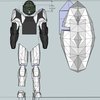My Projects
Projects I Like & Follow
Share this profile
ShareBits
Become a Hackaday.io Member
Create an account to leave a comment. Already have an account? Log In.
Thank you for liking my #Homemade Floating Point Interpreter for 6502 !
Thank you for your interest in my 2:3 Scale VT100 Terminal Reproduction project.
Hello and thank you for liking my #practice backpack project!
Hey there ajlitt and thanks for the follow/like of #LLTP - Light Logic Transistorless Processor
...breaking from form, just for a moment (forgive me!)... I really like your Blinkencard project -- but how hard would it be to add the switches and rework it to use an ESP8266 and either a huge stack of shift reg ('595s and 4021s come to mind!) or input expander chips...?
I'm dirt cheap out of necessity... could probably do it on two perfboards (size is not a significant concern) but I have neither FPGA nor ESP32. Also, not having switches kinda bums me out.
It'd be super cool if I could somehow work in disk emulation with eg a FAT32 SD Card or something... and full emulation of the OS... mind you, I'm absolutely not a programmer, tho... someone else would have to implement that. I can help test but I'm absolutely not competent beyond that.
Thanks! The Blinkencard is an emulation of the underlying logic of an Altair, and is a project I came up with to give me an excuse to play with FPGAs. I'm sure you could do the same on an ESP8266, but it would have to be a software emulation. There's an Arduino-based Altair emulator that could be a basis for such a project on ESP*: https://create.arduino.cc/projecthub/david-hansel/arduino-altair-8800-simulator-3594a6
You may be able to do what you're talking about if you stick to emulating Altairs with little ROM or RAM, and you may need to build baremetal instead of with wifi. The shift registers would certainly work, but may be flickery. I'm only multiplexing in banks of 8 LEDs with the FPGA emulation, and even then I've had to tune the scanning so that the LEDs look right. This may be a place where you could abuse the I2S interface on the ESP8266 to clock the shift registers consistently and quickly.
I'm fairly cheap as well, and I thought about cost from the beginning. My first design used an FTDI FT2232 for firmware loading and serial terminal, but the FTDI was about as much as the FPGA. Using an ESP32 lets me get rid of the FTDI and config flash for the FPGA, and accounting for the support components for the FTDI is about half as expensive. I plan to use the ESP32 for additional stuff like viewing the LEDs and controlling switches from a webpage andacting as a disk drive using a file in the ESP32's flash as a disk image.
Thank you for the like of the #Arcus-3D-C1 - Cable 3D printer . Better late than never.. (finishing it up). :)
Thanks for your interest in my #wESP32: Wired ESP32 with Ethernet and PoE project! :)
Thanks for liking my #EL Wire Clock
I like your cat picture!
Good morning Ajlitt and thanks for liking my Uglytech relay :-)
Thank you for following RGGBer project. It is now live on
https://www.crowdsupply.com/jie-zou/rggber-dev-kit and we will launch it in Aug 2017 and you may sign up for latest information. RGGBer Dev Kit makes embedded vision development easy!
Thank you for liking and following my #LiFePO4wered/Pi+ project ajlitt!
Thanks for your follow. These have been several updates in logs. Enjoy!
Hey, thanks for the like on Holst! I hope you find the documentation interesting as I piece it together. Like your projects, will definitely check them out :)
Thanks for liking my project bro! Sweet cat, should make a hairball supercapacitor!
Thank you for your interest in the Joysix. I will do my best to update and document it!

 ajlitt
ajlitt Tindie
Tindie Sophi Kravitz
Sophi Kravitz Chris Gammell
Chris Gammell Guyrandy Jean-Gilles
Guyrandy Jean-Gilles Andrew Tudoroi
Andrew Tudoroi Vitalii
Vitalii Dan Schnur
Dan Schnur Aaron
Aaron River Wang
River Wang Trevor Flowers
Trevor Flowers wlf647
wlf647 Maave
Maave mkdxdx
mkdxdx Troy Schrapel
Troy Schrapel svofski
svofski Andy Geppert
Andy Geppert Muth
Muth mihai.cuciuc
mihai.cuciuc The-Devil-Itself
The-Devil-Itself Dimitar
Dimitar














Hi! Thanks for your interest in #Compton scattering experiment!